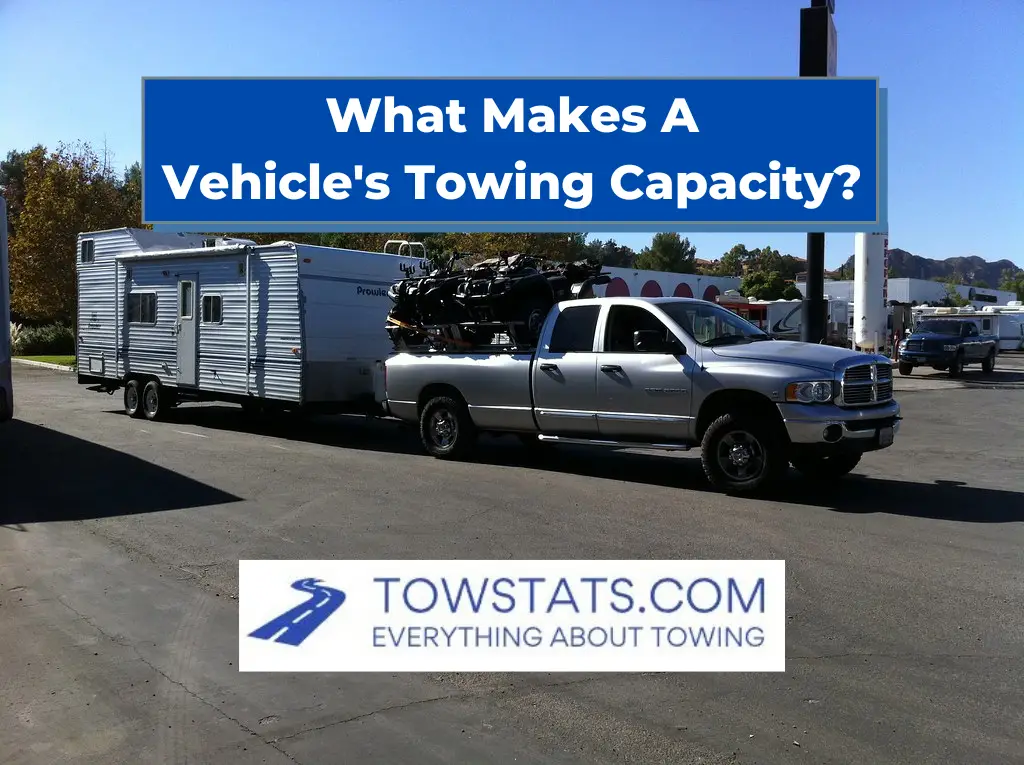When it comes to towing capacity, there are a lot of things that go into making sure your vehicle is able to tow what you need it to. In this guide we’re going to break down what makes a vehicle tow capacity and what you need to know before you hit the open road.
We’ll cover common towing terms and break them down one by one and explain how they all fit together.
What Is Towing Capacity?

A vehicle’s towing capacity is the maximum weight it can pull.
The max towing capacity of a vehicle can change based a few factors, such as the equipment you’re using, how the vehicle is configured, and weight that’s already inside the vehicle from things like passengers and cargo.
Vehicle manufacturers often list the towing capacity of their vehicles in the owner’s manual, but this is just a rough figure.
There are many additional factors that go into calculating a vehicle towing capacity such as GVWR, GAWR, GTW, and more.
Wait, what are all those acronyms for?
If you’re unfamiliar with the different terms and acronyms in the towing world, let’s first get some definitions clear and explain the impact each has on towing.
Common Towing Terms
Gross Vehicle Weight Rating (GVWR)
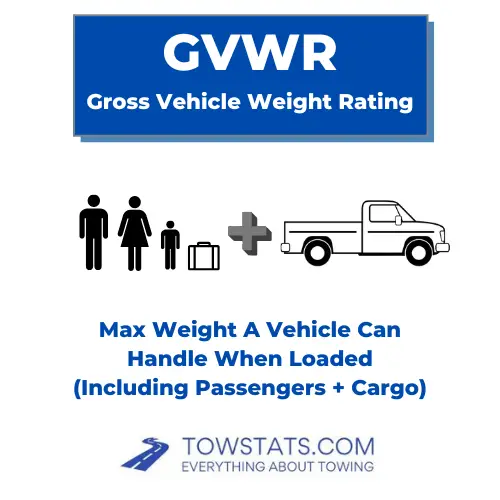
The Gross Vehicle Weight Rating (GVWR) is the maximum weight that a vehicle can handle when loaded, including passengers and cargo.
Gross Combined Vehicle Weight Rating (GCWR or GCVWR)
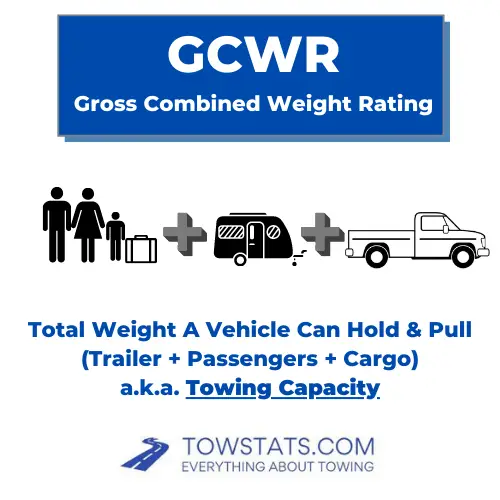
The Gross Combined Weight Rating (referred to interchangeably as GCWR or GCVWR) is the maximum weight a vehicle can hold and pull, otherwise known as towing capacity.
This is the total weight of the vehicle, passengers, cargo, trailer, and anything on the trailer.
Gross Axle Weight Rating (GAWR)
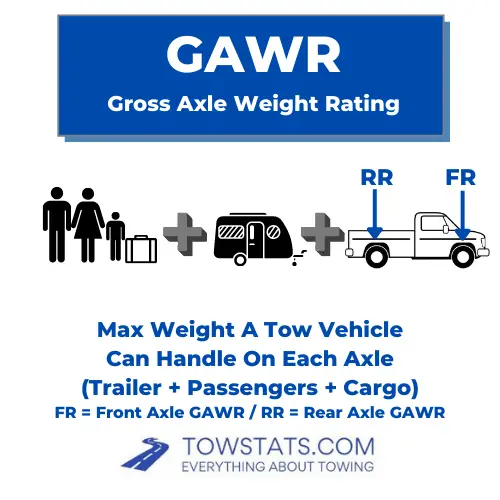
The Gross Axle Weight Rating (GAWR) is the maximum weight a tow vehicle can handle on each axle.
This is usually expressed in FR for the front axle GAWR and in RR for the rear axle GAWR.
Exceeding the GAWR on either axle will damage your vehicle.
Gross Trailer Weight (GTW)
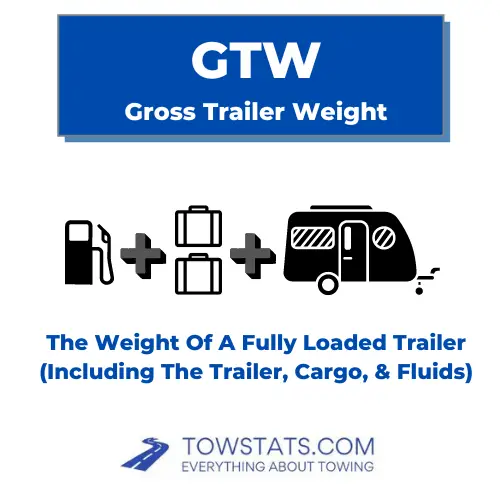
Gross Trailer Weight (GTW) is the total weight of the trailer and cargo being pulled.
You can find GTW by putting your loaded trailer on a vehicle scale or by using a trailer weight scale.
The GTW is not a rating, but just a measurement.
Tongue Weight (TW)
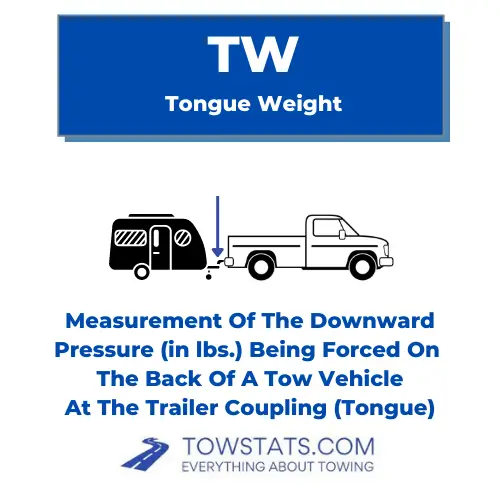
Tongue Weight (TW) is a measurement of the downward pressure (in pounds) being forced on the back of a tow vehicle at the trailer coupling point by the trailer.
Hitches have tongue weight ratings that you must not go over, and having too much or too little tongue weight can also affect the safety of your ride when towing.
Payload
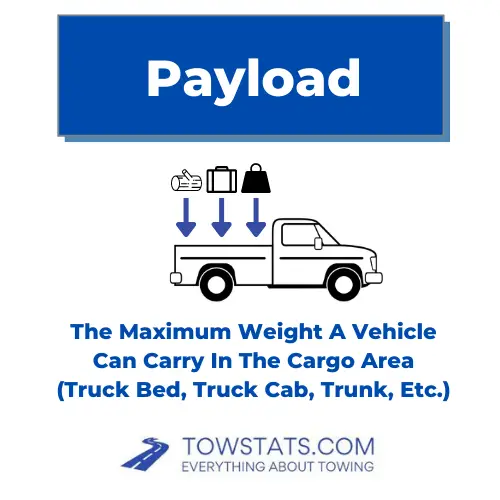
Payload capacity is the maximum amount of weight that a truck or vehicle can haul in the cargo area such as the pickup truck bed, truck cab, or trunk of a vehicle.
The payload is the cargo itself in the bed of the truck or in the trunk of a vehicle.
Curb Weight
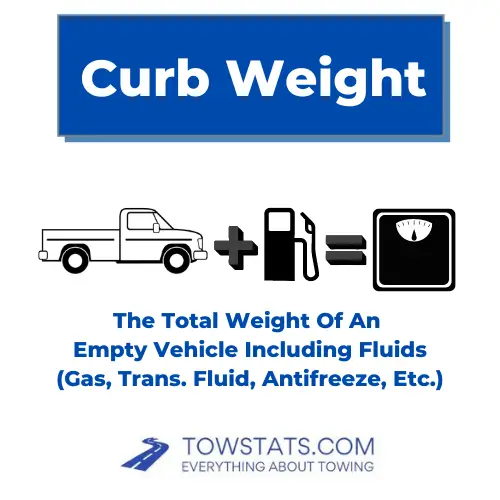
Curb Weight is a measurement of the total weight of a vehicle without passengers or cargo, but does include the weight of all fluids in the vehicle, such as gas and transmission fluid, antifreeze, etc.
Dry Weight
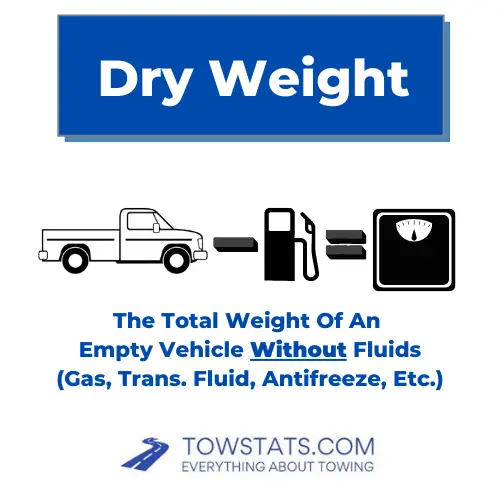
Dry Weight is the weight of an empty vehicle without fluids. So basically, dry weight is curb weight without gas, antifreeze, transmission fluid, etc.
How To Calculate Towing Capacity
You’ll need two things to calculate your vehicle’s towing capacity:
- Your vehicle’s GVWR
- Your vehicle’s Curb Weight
So, here’s how to calculate your vehicle’s towing capacity in a formula:
Towing Capacity = (GVWR – Curb Weight)
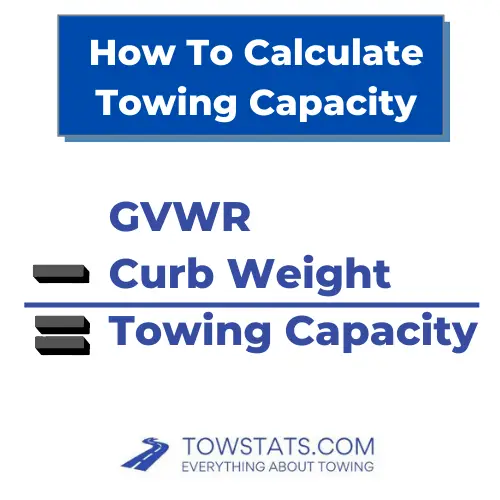
It’s generally not recommended to come within 10% of the high end of that total, so you would want to aim for 90% or less of your vehicle’s towing capacity.
Other Factors Affecting Towing Capacity
We mentioned earlier that how the vehicle is equipped will affect it’s overall towing capacity.
There are a few items to cover here, and each is important to be aware of.
Vehicle Tow Package
Some vehicle manufacturers will offer special tow packages for certain models and trim levels of vehicles they produce.
These tow packages can be as simple as a receiver hitch or other type of trailer hitch, while others may also include different transmissions, transmission coolers, suspension modifications, and so on.
These different specs will affect each vehicle model’s towing capacity, so double check on what equipment is installed in your vehicle with your local dealer or by consulting your vehicle owner’s manual.
Trailer Brakes
Some trailers are equipped with trailer brakes which connect to the tow vehicle so that both units apply their brakes at the same time.
If a trailer has brakes installed on it, you will be able to tow a heavier trailer with your vehicle.
This is referred to as braked vs. unbraked towing capacity.
What Class Hitch You Have
The most common type of trailer hitch is the receiver hitch which accepts different towing accessories such as trailer ball mounts.
Trailer hitch classes range from Class 1 to Class 5, with the towing capacity increasing with the higher number Class rating.
So if your tow vehicle may be limited to a lower towing capacity based on the hitch class that is installed on it.
Read more: how to tell what class hitch I have on my vehicle.
If You Have A Weight Distribution Hitch
A weight distribution hitch is a type of hitch and accessory that helps to distribute the tongue weight across the tow vehicle to reduce the overall tongue weight at the coupling point.
Using a weight distribution hitch will allow you to tow more weight with your vehicle.
Many trailer hitches have separate ratings for regular towing and weight distributed towing, with the weight distributed number being higher.
Your Wheelbase
The wheelbase is the distance between your vehicle’s front and rear axles.
The longer your wheelbase, the better it is for towing something.
if the axles are too close together, you risk lifting the front end of your vehicle up when towing a heavy load.
Why You Shouldn’t Exceed Your Towing Capacity

Exceeding your vehicle’s max towing capacity is dangerous for several reasons:
- It will take you longer than it should to stop when using your brakes.
- Puts extra strain on your drivetrain, leading to engine or transmission damage or failure.
- Towing a trailer above max capacity can also damage your vehicle’s axles and frame.
- You also put your trailer and whatever is on your trailer at risk when towing it with a vehicle that’s not powerful enough.
- Voids your vehicle’s manufacturer warranty.
- Increases the likelihood of you getting into an accident.
Wrapping Up Our Guide To Towing Capacity
We hope you found this guide helpful in understanding what goes in to what makes a vehicle’s towing capacity.
Remember, if you’re ever unsure about your vehicle’s towing capacity, be sure to check with your local dealer or refer to your vehicle owner’s manual.

